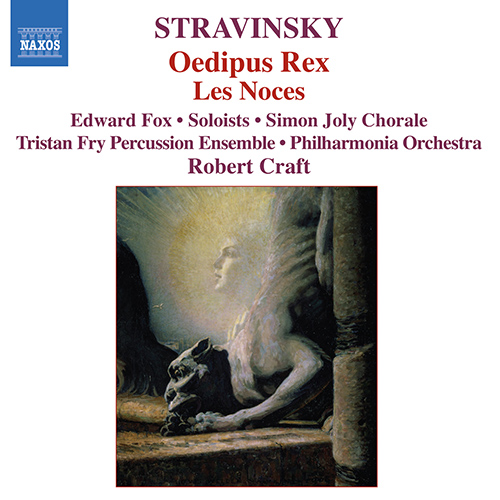 |
|
1 CD -
8.557499 - (c) 2004
|
|
IGOR
STRAVINSKY | ROBERT CRAFT - Volume 1
|
|
|
|
|
|
|
|
| Igor STRAVINSKY
(1882-1971) |
Oedipus
Rex
|
* |
|
52' 21" |
|
|
-
Prologue
|
|
7' 51" |
|
1 |
|
-
Introducing Creon
|
|
7' 48" |
|
2 |
|
-
Introducing Tiresias
|
|
9' 56" |
|
3 |
|
-
Introducing Jocasta
|
|
11' 04" |
|
4 |
|
-
Introducing the Messenger
|
|
9' 05" |
|
5
|
|
-
Epilogue
|
|
6' 38" |
|
6 |
|
|
|
|
|
|
|
Les
Noces
|
**
|
|
24' 10" |
|
|
-
Scene One
|
|
5' 11" |
|
7 |
|
-
Scene Two
|
|
5' 40" |
|
8 |
|
-
Scene Three
|
|
3' 02" |
|
9 |
|
-
Scene Four
|
|
10' 16" |
|
10 |
|
|
|
|
Oedipus Rex
Edward
Fox, Speaker
Jennifer Lane, Mezzo-soprano
Martyn Hill, Tenor
Joseph Cornwell, Tenor
David Wilson-Johnson, Bass-baritone
Andrew Greenan, Bass
SIMON JOLY MALE CHORUS
PHILHARMONIA ORCHESTRA
Robert CRAFT
|
Les Noces
Alison Well, Soprano
Susan Bickley, Mezzo-soprano
Martyn Hill, Tenor
Alan Ewing, Basso-profundo
SIMON JOLY CHORALE
INTERNATIONAL PIANO QUARTET
TRISTAN FRY PERCUSSION ENSEMBLE
Robert CRAFT
|
|
|
|
|
|
Recorded
at: |
|
Abbey
Road Studio One, London (England):
- June 2001 (Oedipus Rex)
- 8/9 January 2001 (Les Noces)
|
|
|
Live / Studio
|
|
Studio |
|
|
Producer |
|
Gregory
K. Squires
|
|
|
Production
Co-ordinator
|
|
Alva
Minoff
|
|
|
Production
Assistant
|
|
Phyllis
Lanini
|
|
|
Engineer |
|
Arne
Akselberg (Oedipus Rex)
Mike Sheady (Les Noces)
|
|
|
Assistant
Engineer
|
|
Mike
Cox
|
|
|
Technical
Engineer
|
|
Dave
Forty
|
|
|
Naxos Editions
|
|
Naxos
| 8.557499 | 1 CD | LC 05537 |
durata 76' 31" | (c)
2004 | DDD
|
|
|
KOCH
(previously released) |
|
Koch
International, Vol. VII |
3-7477-2 | 1 CD | LC 06644 | (p)
2002 | DDD (Oedipus Rex)
Koch International, Vol. VI |
KIC-CD-7514 | 1 CD | LC 06644
| (p) 2002 | DDD (Les Noces)
|
|
|
MusicMasters
(previously released) |
|
Nessuna
|
|
|
Cover |
|
The Sphinx
and the Chimera, 1906 by
Louis Welden Hawkins (1849-1910)
(Musée d'Orsay, Paris, France /
Bridgeman Art Library) |
|
|
Note |
|
-
|
|
|
|
|
|
MusicMASTERS
CLASSICS
Release (1991-1998)

|
KOCH
INTERNATIONAL
Release (1996-2002)

1 CD - 3-7477-2 - Volume VII
(c) 2002 *
 1 CD - KIC-CD-7514
- Volume VI
1 CD - KIC-CD-7514
- Volume VI
(c) 2002 **
|
Oedipus
Rex, based on Sophocles’
tragedy, is an established
twentieth-century classic.
Employing a speaker, male chorus
and orchestra, it represents
Stravinsky’s 1920s
neo-classicism at its peak. Les
Noces, an amalgam of
ballet and dance cantata in four
scenes for solo voices, chorus,
four pianos and seventeen
percussion instruments, depicts
a Russian peasant wedding. One
of only two theatrical works by
Stravinsky to combine music with
a text in his mother tongue, Les
Noces is also his most
Russian work, in which ritual,
symbol and meaning on every
level are part of his direct
cultural heredity.
Oedipus
Rex • Les Noces
Stravinsky conducted the first
performance of Oedipus Rex
(1925-1927) in the Théâtre Sarah
Bernhardt, Paris, on 30th May,
1927, in a double bill with Firebird,
in which George Balanchine
danced the rôle of Kastchei.
Composers - Ravel, Poulenc, and
Roger Sessions among them - were
the first to recognize it as
Stravinsky’s most powerful
dramatic work and one of his
greatest creations. After
hearing Ernest Ansermet conduct
it in London, February 12, 1936,
the young Benjamin Britten noted
in his diary:
‘One of the
peaks of Stravinsky’s output,
this work shows his wonderful
sense of style and power of
drawing inspiration from every
age of music, and leaving the
whole a perfect shape,
satisfying every aesthetic
demand … the established idea
of originality dies so hard.’
Leonard
Bernstein may have been the
first to identify the principal
influence on the music:
‘I remembered
where those four opening notes
of Oedipus come from…
And the whole metaphor of pity
and power became clear; the
pitiful Thebans supplicating
before their powerful king,
imploring deliverance from the
plague … an Ethiopian slave
girl at the feet of her
mistress, Princess of Egypt …
Amneris has just wormed out of
Aida her dread secret … Verdi,
who was so unfashionable at
the time Oedipus was
written, someone for musical
intellectuals of the mid-’20s
to sneer at; and Aida,
of all things, that cheap,
low, sentimental melodrama.
[At the climax of Oedipus’ “Invidia”
aria] the orchestra plays a
diminished-seventh chord …
that favorite ambiguous tool [i.e.,
tool for suggesting ambiguity]
of surprise and despair in every
romantic opera … Aida!
… Was Stravinsky having a
secret romance with Verdi’s
music in those
super-sophisticated mid-’20s?
It seems he was.’ [Charles
Eliot Norton Lectures,
1973]
Bernstein
might also have mentioned the
debt to Verdi in Jocasta’s aria
and her duet with Oedipus. A
photograph of Verdi occupied a
prominent position on the wall
of Stravinsky’s Paris studio in
the 1920s, and on his concert
tours he would go out of his way
to hear Verdi operas, to the
extent of changing the dates of
his own concerts, as he did in
Hanover in December 1931 for a
performance of Macbeth.
In the early 1930s he wrote to
one of his biographers: “If I
had been in Nietzsche’s place, I
would have said Verdi instead of
Bizet and held up The Masked
Ball against Wagner”. In
Buenos Aires, in 1936,
Stravinsky shocked a journalist
by saying: “Never in my life
would I be capable of composing
anything to equal the delicious
waltz in La Traviata”.
Other influences besides Verdi’s
are apparent. The “Gloria”
chorus at the end of Act One,
the Messenger’s music, and the a
cappella choral music in
the Messenger scene are
distinctly Russian, but the
genius of the piece is in the
unity that Stravinsky achieves
with his seemingly disparate
materials.
Les Noces (Svadebka)
ranks high in the by no means
crowded company of indisputable
twentiethcentury masterpieces.
That it does not immediately
come to mind as such may be
attributable to cultural and
linguistic barriers, and to the
ineptitude, partly from the same
causes, of most performances,
for the piece can only be sung
in Russian, both because the
sounds of the words are part of
the music, and because their
rhythms are inseparable from the
musical design. A translation
that satisfied the quantitative
and accentual formulas of the
original could retain no
approximation of its literal
sense. For this reason
Stravinsky, never rigidly averse
to sacrificing the clarity of
sense for sound’s sake,
abandoned an English version on
which he had laboured in the
fall of 1959 and again in
December 1965. It is also the
reason, bizarre as it may seem,
that his own first recording of
Noces was made in English
(1934). No Russian chorus was
available in Paris at the time,
but in any case he abominated
the French version by C. F.
Ramuz, which requires numerous
changes and adjustments in the
musical rhythms.
Performances are infrequent as
well as inadequate. The four
pianos and seventeen percussion
instruments that comprise the
ensemble are not included in the
standard instrumentation of
symphony orchestras. Then, too,
the piece by itself is long
enough for only a short
half-programme, while the few
possible companion works, using
many of the same
instruments—Varèse’s Ionisation,
Bartók’s Sonata for Two
Pianos and Percussion,
Antheil’s Ballet mécanique
(an arrant plagiarism)—derive
from it too obviously as
instrumental example.
As a result of the obstacles of
language and culture, audiences
do not share in the full meaning
of the work, hearing it as a
piece of “pure” music; which, of
course, and as Stravinsky would
say, is its ultimate meaning.
But Stravinsky notwithstanding,
Svadebka is a dramatic
work, composed for the stage,
and informed with more meanings
on the way to that ultimate one
than any other opus by the
composer. The drama is his own,
moreover, and he is responsible
for the choice of the subject,
the form of the stage spectacle,
the ordonnance of the texts. Svadebka
is in fact the only theatrical
work by him, apart from the much
slighter Renard, that
combines music with a text in
his mother tongue, the only work
in which ritual, symbol, meaning
on every level are part of his
direct cultural heredity.
It is also the one Stravinsky
work that underwent extensive
metamorphoses. Svadebka
occupied his imagination
throughout a decade and, in
aggregate, took more of his time
than any other work of the same
length. The sketches, in
consequence, offer a unique
study of his processes of growth
and refinement. The reasons for
the long gestation are, first,
that Stravinsky several times
suspended work to compose other
music, which, in each case, left
his creative mind with altered
perspectives. Second, he was
creating something so new, both
musically, in its heterophonic
vocalinstrumental style, and in
theatrical combination and
genre, an amalgam of ballet and
dramatic cantata, that he was
himself unable to describe it.
“Russian Choreographic Scenes,”
his subtitle on the final score,
neglects to mention that the
subject is a village wedding and
that the four scenes depict the
ritual braiding of the Bride’s
tresses, the ritual curling of
the Groom’s locks, the departure
of the Bride for the church, and
the wedding feast.
Robert
Craft
|
|

